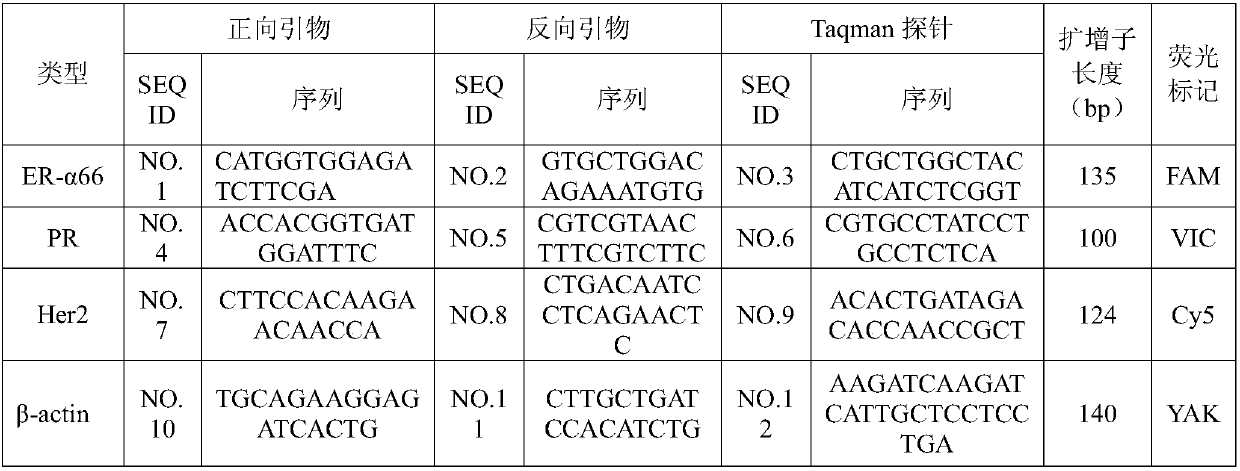Breast cancer molecular typing real-time fluorescent multiple PCR (Polymerase Chain Reaction) primer and kit and application thereof
A molecular typing and real-time fluorescence technology, applied in the field of nucleic acid detection, can solve problems such as poor prognosis and affect disease diagnosis, and achieve the effects of strong specificity, short detection time and high accuracy
- Summary
- Abstract
- Description
- Claims
- Application Information
AI Technical Summary
Problems solved by technology
Method used
Image
Examples
Embodiment 1
[0050] (1) Design primer / probe combination
[0051] According to the mRNA sequence of each molecular receptor of breast cancer released by GenBank (ER-α66 gene: NM_000125.3; PR gene: NM_000926.4; Her2 gene: NM_001005862.2), the sequences were compared to find conserved regions, using Beacon The software designed primers and Taqman probes for multiplex RT-PCR on mRNA transcribed by these receptor genes, and designed three pairs of primers for each molecule (Table 1). The resulting primer / probe combinations were subjected to BLAST analysis on the NCBI website to ensure no cross-reaction with other genes that may be present in the sample. The different designed primers and probes were tested for crossover, and a total of 81 experiments were carried out. Experimentally validate the primer combination for its best performance. Simultaneously, single-plex RT-PCR primers were designed as controls.
[0052] Table 1 Multiplex RT-PCR Primer / Probe Combinations
[0053]
[0054] (...
Embodiment 2
[0063] (1) Prepare a positive control and detect the minimum detection amount
[0064] ER-α66, PR, and Her2 positive cell lines MFC-7, Bcap-37, and SK-BR-3 (purchased from Shanghai Gefan Biotechnology Co., Ltd.) were cultured, passaged, and amplified, and the cells were collected and extracted. For mRNA, the primers shown in Table 2 were used as amplification primers for RT-PCR, wherein the reaction system (25 μl) was: template 10 μl, 2×RT-PCR Buffer 12.5 μl, 25×RT-PCR Enzyme Mix 1 μl, each primer / Probe combination 1.5 μl, wherein, the final concentration of the template is 5 μM, and the final concentration of each primer / probe is 0.5 μM; then carry out RT-PCR on a real-time fluorescent PCR instrument (ABI 7500, Applied Biosystems) for each reaction tube according to the following procedure Reaction: 50°C for 15min (reverse transcription), 95°C for 10min (hot start); 95°C for 8s (denaturation), 60°C for 34s (annealing / extension, fluorescence signal collection), 40 cycles. T...
Embodiment 3
[0070] RNA was extracted from fresh breast cancer tissue samples or tissue sections, and 2 μl of internal control (final concentration was 5 μM) was added to the samples before extraction, and then RNA was extracted from the samples ( mRNA DIRECT TM Purification (life)). Then use the primer combinations shown in Table 2 as amplification primers for RT-PCR. The reaction system (25 μl) is: RNA template 10 μl, 2×RT-PCR Buffer 12.5 μl, 25×RT-PCR Enzyme Mix 1 μl, each primer / Probe combination 1.5 μl, in which the final concentration of the sample is 5 μM, and the concentration of each primer / probe is 0.5 μM; the amplification program is: 50 ° C for 15 min (reverse transcription), 95 ° C for 10 min (hot start); 95 ° C 8s (denaturation), maintained at 60°C for 34s (annealing / extension, collecting fluorescence signals), 40 cycles.
[0071] Result judgment: if the corresponding fluorescent signal generation index Ct value of a certain receptor gene is less than 33, it is positive,...
PUM
 Login to View More
Login to View More Abstract
Description
Claims
Application Information
 Login to View More
Login to View More - R&D
- Intellectual Property
- Life Sciences
- Materials
- Tech Scout
- Unparalleled Data Quality
- Higher Quality Content
- 60% Fewer Hallucinations
Browse by: Latest US Patents, China's latest patents, Technical Efficacy Thesaurus, Application Domain, Technology Topic, Popular Technical Reports.
© 2025 PatSnap. All rights reserved.Legal|Privacy policy|Modern Slavery Act Transparency Statement|Sitemap|About US| Contact US: help@patsnap.com



